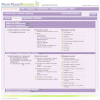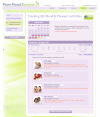Web-Based Intervention for Postpartum Depression: Formative Research and Design of the MomMoodBooster Program
- PMID: 23612274
- PMCID: PMC3626158
- DOI: 10.2196/resprot.2329
Web-Based Intervention for Postpartum Depression: Formative Research and Design of the MomMoodBooster Program
Abstract
Background: Postpartum depression is a significant public health problem affecting approximately 13% of women. There is strong evidence supporting Cognitive Behavioral Therapy (CBT) for successful psychosocial treatment. This treatment model combines cognitive and behavioral strategies to address pessimism, attributions for failure, low self-esteem, low engagement in pleasant activities, social withdrawal, anxiety, and low social support. Encouraging results have been reported for using Web-based CBT interventions for mental health domains, including the treatment of panic disorder, post-traumatic stress disorder, and complicated grief and depression. To date, however, Web-based interventions have not been used and evaluated specifically for the treatment of postpartum depression.
Objective: We describe the formative work that contributed to the development of our Web-based intervention for helping to ameliorate symptoms of postpartum depression, and the design and key components of the program.
Methods: A total of 17 focus group participants and 22 usability testers, who shared key characteristics with the participants of our planned feasibility study, took part. The proposed structure and ingredients of the program and mock-ups of selected webpages were presented to focus group participants. At various points, participants were asked a series of thought questions designed to elicit opinions and set the occasion for group discussion. At the end of the session, participants were asked to describe their overall reaction to the proposed features of the program emphasizing candid opinions about what they did not like and features they thought were missing and should be added. Usability testers were asked to interact with a series of seven different Web-based interactions planned for the program while receiving minimal direction. Each tester was asked to describe her thoughts using a think-aloud technique. They were then asked to consider all that they had learned about the program and complete the System Usability Scale that we adapted slightly to be appropriate for evaluating the proposed website. Transcripts from the focus groups and usability tests were reviewed by research team members for overarching themes with particular emphasis on suggested changes. A list emerged, and iterative and incremental adjustments were made as a result.
Results: The qualitative and quantitative data gathered in the focus groups and usability sessions reported here suggest that the new mothers involved had largely positive reactions to the major features of the program and that those program features performed well in terms of usability.
Conclusions: An overview of the eventual design, architecture, and key program ingredients of the MomMoodBooster program is provided including innovative features supplementing 6 core CBT sessions, which include a partner's website, a library, and individual feedback by a personal coach.
Keywords: Web-based intervention; formative research; postpartum depression.
Conflict of interest statement
Conflicts of Interest: None declared.
Figures






Similar articles
-
Development and Usability Testing of a Web-Based and Therapist-Assisted Coping Skills Program for Managing Psychosocial Problems in Individuals With Hand and Upper Limb Injuries: Mixed Methods Study.JMIR Hum Factors. 2020 May 6;7(2):e17088. doi: 10.2196/17088. JMIR Hum Factors. 2020. PMID: 32374265 Free PMC article.
-
A Web-Based Cancer Self-Management Program (I-Can Manage) Targeting Treatment Toxicities and Health Behaviors: Human-Centered Co-design Approach and Cognitive Think-Aloud Usability Testing.JMIR Cancer. 2023 Jul 21;9:e44914. doi: 10.2196/44914. JMIR Cancer. 2023. PMID: 37477968 Free PMC article.
-
Usability Testing of a Web-Based Empathy Training Portal: Mixed Methods Study.JMIR Form Res. 2023 Apr 4;7:e41222. doi: 10.2196/41222. JMIR Form Res. 2023. PMID: 37014693 Free PMC article.
-
[A group cognitive behavioral intervention for people registered in supported employment programs: CBT-SE].Encephale. 2014 Jun;40 Suppl 2:S81-90. doi: 10.1016/j.encep.2014.04.005. Epub 2014 Jun 16. Encephale. 2014. PMID: 24948482 Review. French.
-
Psychological interventions to improve self-management of type 1 and type 2 diabetes: a systematic review.Health Technol Assess. 2020 Jun;24(28):1-232. doi: 10.3310/hta24280. Health Technol Assess. 2020. PMID: 32568666 Free PMC article.
Cited by
-
Internet-based interventions for postpartum depression: A systematic review and meta-analysis.Nurs Open. 2021 May;8(3):1125-1134. doi: 10.1002/nop2.724. Epub 2020 Dec 29. Nurs Open. 2021. PMID: 33373101 Free PMC article.
-
Exploring the Use of Information and Communication Technology by People With Mood Disorder: A Systematic Review and Metasynthesis.JMIR Ment Health. 2016 Jul 1;3(3):e30. doi: 10.2196/mental.5966. JMIR Ment Health. 2016. PMID: 27370327 Free PMC article.
-
Health professionals' perspective on the promotion of e-mental health apps in the context of maternal depression.PLoS One. 2017 Jul 12;12(7):e0180867. doi: 10.1371/journal.pone.0180867. eCollection 2017. PLoS One. 2017. PMID: 28704442 Free PMC article.
-
Treating postpartum depression in rural veterans using internet delivered CBT: program evaluation of MomMoodBooster.J Behav Med. 2021 Aug;44(4):454-466. doi: 10.1007/s10865-020-00188-5. Epub 2020 Oct 14. J Behav Med. 2021. PMID: 33052526 Free PMC article.
-
Mamma Mia - A randomized controlled trial of an internet-based intervention for perinatal depression.Psychol Med. 2019 Aug;49(11):1850-1858. doi: 10.1017/S0033291718002544. Epub 2018 Sep 7. Psychol Med. 2019. PMID: 30191779 Free PMC article. Clinical Trial.
References
-
- O'Hara MW, Swain AM. Rates and risk of postpartum depression: A meta-analysis. Int Rev Psychiatry. 1996;8(1):37–54.
-
- Gaynes BN, Gavin N, Meltzer-Brody S, Lohr KN, Swinson T, Gartlehner G, Brody S, Miller WC. Perinatal depression: prevalence, screening accuracy, and screening outcomes. Evid Rep Technol Assess (Summ) 2005 Feb;(119):1–8. http://archive.ahrq.gov/clinic/epcsums/peridepsum.pdf - PMC - PubMed
-
- Goodman SH, Gotlib IH. Risk for psychopathology in the children of depressed mothers: a developmental model for understanding mechanisms of transmission. Psychol Rev. 1999 Jul;106(3):458–90. - PubMed
-
- Milgrom J, Westley D, Gemmill AW. The mediating role of maternal responsiveness in some longer-term effects of postnatal depression on infant development. Infant Behav Dev. 2004;27(4):443–454.
Grants and funding
LinkOut - more resources
Full Text Sources
Medical

